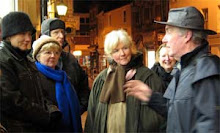
Image credit Joan De La Haye
The Festival of Samhain; a date we now celebrate as Halloween, or All Hallows Eve, has its roots in ancient Celtic beliefs. The Celtic Druid's end of summer festival - Samhain, began at sundown on the 31st October (their new years eve) and lasted for three days. It was a celebration in honour of the dead to give thanks to the Sun god - Lugh, who’s passing indicated the end of summer and the beginning of winter.
It was a brief moment in time, when the Celts firmly believed the veil between the living and the dead was at its thinnest and that the dead were able to breach the veil and pass into the realm of the living. Once there, they would seek out their homes and loved ones. It was also a dangerous period; dangerous because the Celts believed evil spirits could also cross the liminal. Thes transition by the dead was essential to ensure a rich and prosperous harvest for the following year. It was also a time when Samhain - the God of the dead, who had collected up all the souls of those who had died the previous year, would set them free to join the Druid heaven.
The Halloween we celebrate today (or not as the case may be, preferring to give the impression of being out so avoiding having to open the door to the neighbourhood's little horrors - bah humbug!) has been integrated somewhat reticently it has to be said, into Christian celebrations, again a three day event comprising of All Saints Day, followed by All Souls Day or "The Day of the Dead" and finally, All Hallows Eve, which was eventually shortened to Halloween. Halloween has survived many attempts to eradicate it from the calendar by the Christian church, even now many Christians choose not to celebrate it simply because of its pagan roots, some are even convinced it has satanic links, which it does not.
Any similarity between Samhain and today’s Halloween celebrations is purely coincidental. The celebration was popularized by the Americans centuries ago, as are the traditions of bobbing for apples, Jack-o-Lanterns (lit pumpkins) trick-or-treat and of course dressing up as ghosts and ghouls etcetera. These traditions are loosely based on Celtic customs, for example: trick-or-treat was probably derived from the practice of leaving a ‘treat’ (milk or cheese) outside the doors of friends homes to appease evil spirits. The dressing up as ghosts and ghouls is to symbolize the good and bad spirits as they walk with the living.
The most favoured custom on Halloween, has to be the Pumpkin or Jack-o-Lantern.
History of the Jack-o-Lantern.
People have been making jack-o-lanterns at Halloween for centuries. The practice originated from an Irish myth about a man nicknamed "Stingy Jack." According to the story, Stingy Jack invited the Devil to have a drink with him. True to his name, Stingy Jack didn't want to pay for his drink, so he convinced the Devil to turn himself into a coin that Jack could use to buy their drinks. Once the Devil did so, Jack decided to keep the money and put it into his pocket next to a silver cross, which prevented the Devil from changing back into his original form. Jack eventually freed the Devil, under the condition that he would not bother Jack for one year and that, should Jack die, he would not claim his soul. The next year, Jack again tricked the Devil into climbing into a tree to pick a piece of fruit. While he was up in the tree, Jack carved a sign of the cross into the tree's bark so that the Devil could not come down until the Devil promised Jack not to bother him for ten more years. Soon after, Jack died. As the legend goes, God would not allow such an unsavoury figure into heaven. The Devil, upset by the trick Jack had played on him and keeping his word not to claim his soul, would not allow Jack into hell. He sent Jack off into the dark night with only a burning coal to light his way. Jack put the coal into a carved out pumpkin and has been roaming the Earth with it ever since. The Irish began to refer to this ghostly figure as "Jack of the Lantern," and then, simply "Jack O'Lantern."
Source ~ The History Channel ~
Halloween, in my opinion, is a harmless celebration where kids can go trick-or-treating and scare the pants of the neighbours, whilst us adults have a good excuse to dress up like throwbacks from the Rocky Horror Picture Show. But remember the witching hour dear reader; that time between 12 midnight and 1am on the 31st October when the veil between the living and the dead will be at its most fragile. For who knows what 'orrible creepy nasties might piggyback on the shoulders of the benign and crossover to the realm of the living.
Have a good one!






No comments:
Post a Comment